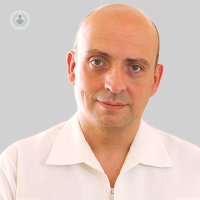Trastorno Obsesivo-Compulsivo: Síntomas, causas y tratamiento
Written by:Obsessive-compulsive disorder (OCD) is a relatively frequent psychiatric disorder that affects throughout life to 2-3% of the population. The doctor. Playà Busquets has more than 20 years of experience in the treatment of patients with this disorder, which is characterized by the presence of obsessions and / or compulsions.
Obsessions are ideas, images, mental impulses or preoccupations of an intrusive and unwanted character that repeatedly break into the mental activity of the individual, causing in the person who suffers an attempt to resist them. They are often perceived as their own thoughts, even though they are involuntary, meaningless, disagreeable and often repulsive.
Common Symptoms of Obsessive Compulsive Disorder (OCD)
The most common symptoms of these patients in the psychiatric clinic usually relate to:
- Repeated fears of killing a loved one;
- Concern about dirt, pollution and contagion;
- Recurring thoughts of not doing things right;
- Concern about the shape and / or functioning of parts of the body;
- Blasphemous thoughts or sexual themes;
- Fear of losing or forgetting something;
- Feelings that certain things must follow an order or be in a certain place or position;
- Sounds, words, numbers or nonsense images. They often cause a varying degree of distress or anxiety.

Compulsions are ritualized forms of behavior or mental acts (mental compulsions), which are repeated over and over again, in order to reduce the discomfort caused by obsessions. They often provide incomplete and short-lasting relief. They are generally recognized by the patient as meaningless and ineffective.
Typically, patients with OCD present up to 30% of cases, a motor tics disorder. In addition, OCD is often associated with anxiety disorders (panic, social anxiety, generalized anxiety, specific phobia), and also to depressive disorder or bipolar disorder.
Causes of Obsessive Compulsive Disorder (OCD)
OCD affects between 2-3% of the population throughout the life, happening in equal frequency in men and women. The mean age at onset is around 20 years of age, although 25% of cases start at age 14. Its onset beyond the age of 35 is unusual (<5%). It is a chronic course disorder.
The symptoms of internalization, the greater negative emotionality and the behavioral inhibition in infancy are possible temperamental risk factors. At the environmental level, physical and sexual abuse in childhood, as well as other traumatic events, have been associated with an increased risk of developing OCD. Some children may suddenly develop obsessive-compulsive symptoms in the context of a group A beta-hemolytic streptococcal (PANDAS) postinfectious autoimmune syndrome.
At the genetic level, no specific genes involved in OCD have been found. However, the OCD rate in first-degree relatives of adults with OCD is 2 times higher than in the general population, and in those who initiate OCD during childhood the rate is up to 10 times higher.
Functional imaging studies show a decreased metabolism in the head of the caudate nuclei of the brain base, as well as increased metabolism in the frontal orbital cortex, as well as the involvement of serotonergic neurotransmission systems, and also, dopaminergic and glutamatergic, in the pathophysiology of OCD.
Psychologically, the relationship between obsessions and compulsions, as well as their quality of self-reinforcement, are explained by the principles of learning theory. As obsessional thoughts recur, anxiety increases, and although compulsions temporarily reduce anxiety, patients soon find themselves trapped in a positive feedback loop, in which compulsive behavior reinforces itself with the temporary relief of the anxiety.
Treatment of obsessive-compulsive disorder (OCD)
At the pharmacological level and as the first choice, serotonergic antidepressants are used. Usually higher doses are required than those used in other disorders, and it should be noted that the therapeutic action usually starts within 4-8 weeks, and that a manifest efficacy may not be observed until after 12 weeks.
The psychological treatment of choice is cognitive behavioral therapy, with strategies of exposure-prevention of response (RPE).
The association of pharmacological treatment with psychological treatment is the technique that allows better results to be obtained in most cases.
In cases of resistance to treatment, different serotonergic antidepressant drugs are usually combined, or potentiated with antipsychotics (dopaminergic) or other drugs.
When all previous strategies fail, and in severe cases of OCD, highly invalidating, functional neurosurgery (deep brain stimulation) or lesion neurosurgery (anterior capsulotomy, subcauded tractomy, limbic leukotomy, anterior cingulotomy) may be indicated.


